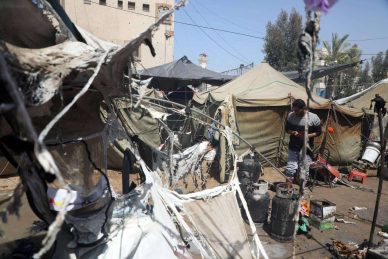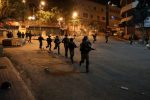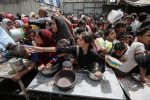GAZA, (PIC)
Every time you pass by the Al-Rasheed Street, you are most likely to discover new horrors, for this area had been heavily bombarded during the Israeli aggression that continued for more than 15 months.
Making one journey through this area is never enough to recognize all the blights that have befallen it, including its tourist sites, residential buildings, fancy houses, chalets, and agricultural fields.
Over the past years, the area had become one of the most remarkable aesthetic landmarks in Gaza. That was after the Qatari committee for reconstruction of Gaza had developed a series of construction projects, announced during the Amir Al-Walid (the father) Sheik Hamad Al-Thani’s visit to the Strip following the 2008-2009 Israeli aggression.
Both sides of the road included projects such as agricultural and tourist sites that played an active role in the Gaza economy, but the Israeli heavy bombardment destroyed them all without leaving any trace.
Mediated by Egypt and Qatar and secured by the US, the ceasefire agreement between the Palestinian resistance and the Israeli occupation stipulated that the Al-Rasheed coastal road would be set for comers and goers on foot while vehicles are banned from passing this street.
However, Palestinians started to use animal-drawn carts as a transportation means in addition to the locally known three-wheel vehicle called tok-tok.
Through these transportation means, a journey of toil is taken from Tabbat Nuwery, the area between Nuseirat refugee camp entrance and the start of Al-Rasheed Street, into the Nabulsi crossroads. The hardship of this journey is not only due to the length of the road but also to its roughness.
The Israeli army, staying in the area throughout the 15-month aggression, deliberately vandalized and obliterated its platforms and landmarks, turning it into a rough place full of sand hills, clay, and stones.
Mental and physical torture
While the PIC correspondent headed to the Gaza city via a tok-tok through Al-Rasheed, he met Abu Ali, an old man in his fifties.
Abu Ali had found a work opportunity in Deir Al Balah in the central Gaza, where he had been displaced. Since he returned to his home in Gaza city, he has been making this journey to his work in Deir Al Balah on a daily basis.
“It’s a daily journey of torture that breaks the back and shakes each atom of the body, not only because of the tok-tok that is not suitable for riders but also because of the rough and damaged roads full of holes and pits,” Abu Ali explained his daily suffering through the street.
But the mental torture is not any easier, as Abu Ali has to see all the destruction and eyesores every day. No houses, landmarks, or fields. No life left in this street. Only passers-by forced to make a journey for a necessity.
“Sometimes when I pass the street, I ask myself, ‘has this street been a desert for ages?’ But then I answer that the most aggressive army ever has passed by it.”
While the correspondent talked to Abu Ali, his phone rang, and it was his wife asking if he has arrived yet.
“Honestly, I don’t know where I am right now,” was Abu Ali’s answer, as the only thing he knew was that they were crossing Al-Rasheed Street. No mark or sign left for the riders to recognize the start, middle, or end of the way.
Homesickness
Abu Omar, in his thirties, who works in composing alternative power sources, accompanied Abu Ali and the correspondent in their journey through this way. He was speechless all the time, until he finally said, “my hobby used to be to leave work in Gaza city to home in Nuseirat through this street, especially in spring time.”
“I have never felt that this was an 18-kilometre walk, as the al Rasheed Street used to be so attractive, with its vast agricultural fields,” Abu Omar explained.
He further added that he feels homesick while he walks through the street these days, as if it is never Al-Rasheed Street that had been there over the past years foregoing the brutal aggression.
The story of Abu Ali and Abu Omar shows only one example of the places that the Israeli occupation destroyed through its most violent aggression.
Despite all the pain, the Palestinian people are determined to craft ways to live and stay resilient in their homeland, foiling all the Israeli forcible displacement plans.















